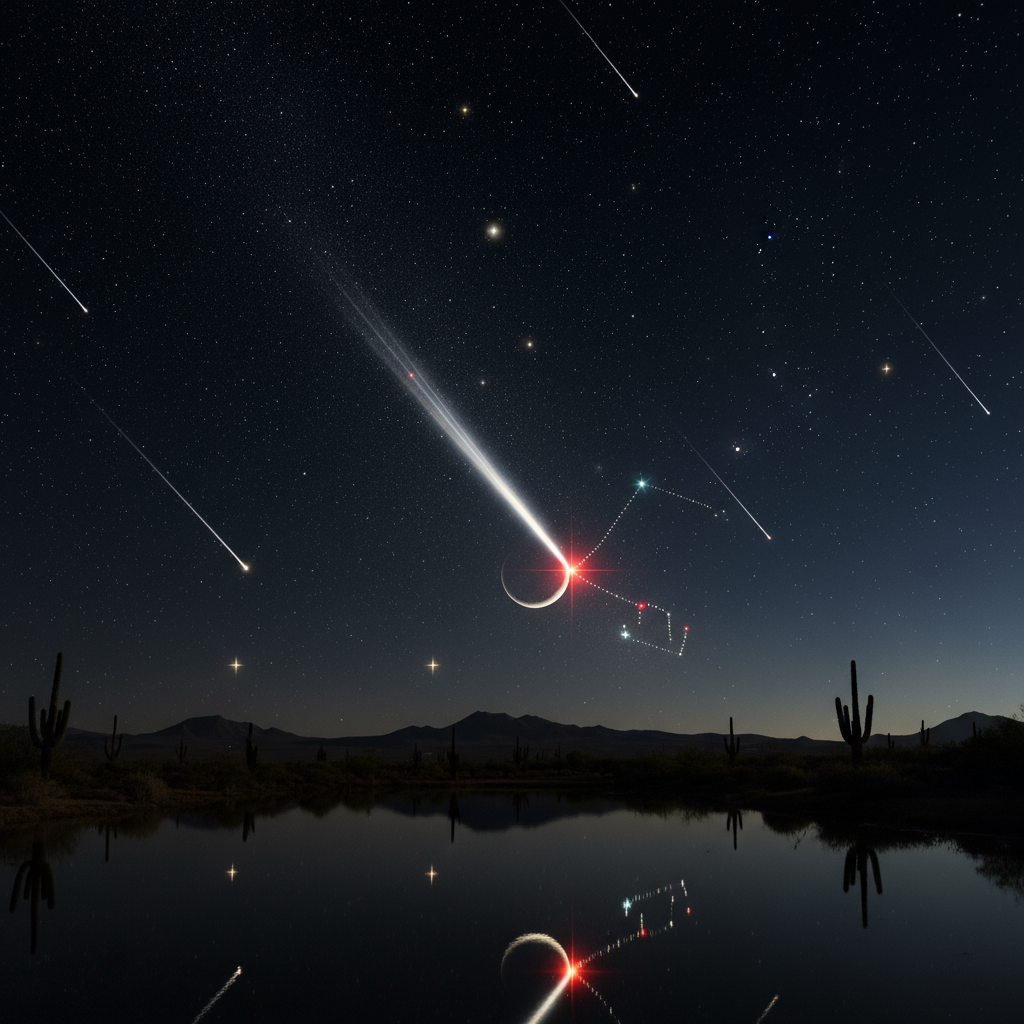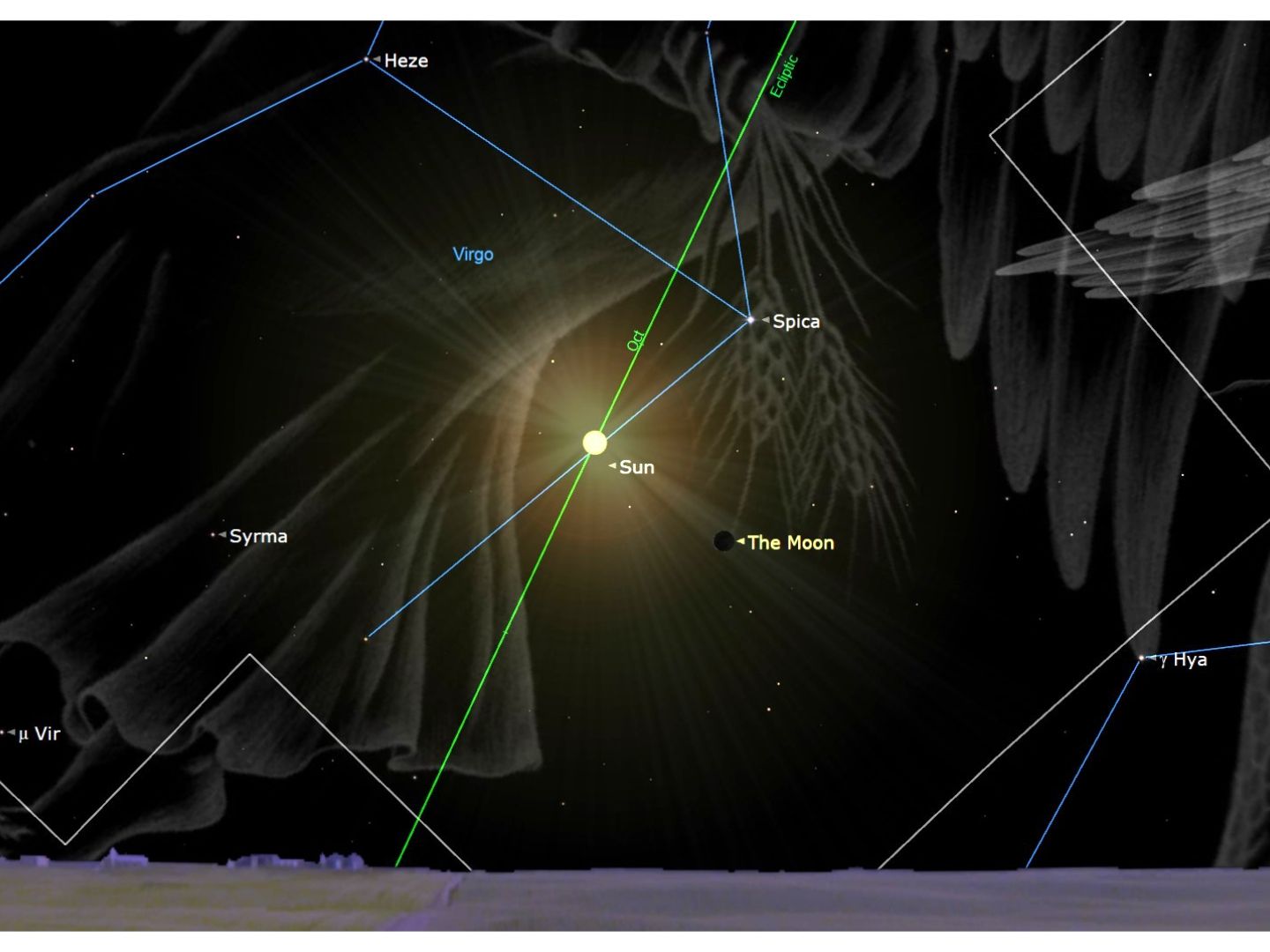
New Moon Oct 21, 2025: Orionid Meteor Shower Peak & Antares Occultation
The new moon on October 21, 2025, will create ideal dark skies for the peak of the Orionid meteor shower. Three days later, the young moon will occult the bright red star Antares, a rare event visible mainly from parts of South America and the Falklands. Alongside these phenomena, planets like Saturn, Jupiter, and Venus will be prominently visible, with Mars and Mercury better seen in southern mid-latitudes. As northern summer constellations fade, autumn stars and southern sky features like the Southern Cross and Scorpio become prominent. Astrologically, the New Moon in Libra signals a time of balance and renewal in relationships, encouraging authentic love and harmony. This period offers a spectacular celestial showcase combined with cosmic reflections.
Summary
The new moon will see dark skies for the peak of the Orionid meteor shower, while three days later the young moon will pass in front of the red star Antares for observers in South America and the Falklands.
The upcoming new moon phase on Tuesday, Oct. 21, 2025, will provide optimal dark skies for viewing the peak of the Orionid meteor shower. Shortly after, the young moon will occult the bright red star Antares, offering a rare celestial event for observers in parts of South America and the Falklands. Alongside these phenomena, several planets will be prominently visible in the night skies, and various well-known constellations will grace observers in both hemispheres. Additionally, the New Moon in Libra is believed to signify a cosmic reset in relationships, fostering balance and authentic love energy.
Key points:
- The new moon on Oct. 21, 2025, coincides with the peak of the Orionid meteor shower, ideal for star gazing due to the absence of moonlight.
- Three days later, a young moon will pass in front of Antares, the red supergiant star, creating an occultation observable in South America and the Falklands.
- Major planets Saturn, Jupiter, and Venus will be visible across different latitudes, with Mars and Mercury more visible in southern mid-latitudes.
- Prominent constellations transition as northern summer zodiac constellations set and fall stars become prominent; the Southern Cross and Scorpio are visible in the Southern Hemisphere.
- The New Moon in Libra heralds a period of relational balance and renewal, accompanied by tarot readings offering insight into personal love lives.
---
Understanding the new moon and celestial alignments
The new moon phase occurs when the sun and moon align on the same celestial line, rendering the moon invisible from Earth as its sunlit side faces away. For this month, the precise moment of new moon will be Tuesday, Oct. 21, 2025, at 8:25 a.m. EDT (1225 UTC), as reported by the U.S. Naval Observatory. While new moons typically are unobservable, they play a crucial role by providing dark skies optimal for meteor showers and other celestial events.
About twice a year, the alignment can create a solar eclipse; however, this new moon will not produce one. Instead, three days later on Oct. 24, the young moon will occult the bright red star Antares, located in the Scorpius constellation. Occultations like this are less frequent to see due to the small geographical area from which they are observable, as the moon's shadow on Earth is relatively narrow.
The Oct. 24 occultation of Antares
This particular occultation will be visible primarily from parts of South America and the Falklands. For observers in Ushuaia, Argentina, the event begins at 10:35 p.m. local time with Antares disappearing behind the moon's upper right quadrant at about 15 degrees above the southwestern horizon. The star will re-emerge at 11:23 p.m. when the moon is about 9 degrees above the horizon. Punta Arenas, Chile, offers a similar viewing window beginning at 10:37 p.m.
In northern regions such as New York City, the moon will appear below Antares on the day of the occultation but the event will not be visible as it occurs below the horizon.
Visible planets across hemispheres in late October
For those unable to observe the occultation, the night sky presents other highlights:
- Saturn will be the first planet visible after sunset in northern cities such as New York, rising at 5:54 p.m. and reaching 46 degrees altitude by late evening in the Aquarius constellation.
- Jupiter rises late night at 11:16 p.m. EDT in Gemini constellation, near Pollux, shining steadily in contrast to twinkling stars.
- Venus will appear just before dawn, visible until sunrise.
In the Southern Hemisphere, planetary visibility improves as summer approaches:
- Saturn, Jupiter, and Venus appear higher in the sky at later local times.
- Mars and Mercury become more observable from mid-latitudes such as Santiago, Chile, often obscured by sunset glare in the north.
- Mercury and Mars remain visible above the western horizon well into the evening, providing notable viewing opportunities.
Recognizable stars and constellation shifts
In northern latitudes, late October marks the disappearance of summer zodiac constellations such as Sagittarius, Ophiuchus, and Scorpio, making room for autumn stars. The Summer Triangle (Vega, Altair, Deneb) is near zenith, while the Great Square of Pegasus and Andromeda emerges in the eastern sky. Familiar northern constellations such as Cassiopeia and Perseus become increasingly visible as the night progresses. The Big Dipper remains near the horizon and serves as a pointer to Polaris, the North Star.
In the Southern Hemisphere, darkness falls around 9 p.m., revealing stars like Acrux in the Southern Cross low in the south-southwest. Nearby stellar landmarks include Hadar and Rigil Kentaurus. Further southeast, Achernar at the end of the Eridanus constellation and the Phoenix constellation are observable. Scorpio appears upside down with its claws near the horizon and curving tail forming a fishhook toward the zenith.
Orionid meteor shower and Comet Lemmon
The new moon phase creates ideal viewing conditions for the Orionid meteor shower, which is active until Nov. 7 and peaks from Oct. 20 into Oct. 21. These meteors, associated with the debris of Halley’s Comet, will be clearly seen against the dark skies.
Simultaneously, the rare green Comet C/2025 A6 (Lemmon) will reach its closest approach to Earth on Oct. 21, marking its last appearance for over 1,300 years, providing another rare astronomical spectacle for skywatchers.
The New Moon in Libra: cosmic reset in relationships
Astrologically, the New Moon in Libra signifies a time of balance, renewal, and connection. Ruled by Venus—the planet of beauty and attraction—this lunar event opens hearts and invites authentic love and peace. It follows a season of eclipses, symbolizing calm and new beginnings.
A tarot reading for each zodiac sign reveals personalized guidance to navigate love and relationships during this time. Themes include challenging existing imbalances, committing to partnerships, recognizing self-worth, seeking stability, and embracing transformation. The reading encourages individuals to align their desires with intentional actions to foster positive developments in love.
Moon phases and what to expect next
Tonight’s new moon means the moon is invisible in the night sky, representing the start of a new lunar cycle lasting approximately 29.5 days. According to NASA, there are eight principal moon phases:
1. New Moon – moon between Earth and sun, invisible. 2. Waxing Crescent – small light on the right side. 3. First Quarter – half moon illuminated on the right. 4. Waxing Gibbous – more than half illuminated but not full. 5. Full Moon – fully illuminated visible face. 6. Waning Gibbous – illumination decreasing on right. 7. Third Quarter – half moon illuminated on the left. 8. Waning Crescent – small light remaining on left before new cycle.
The next full moon will occur on Nov. 5, continuing the rhythmic dance of lunar illumination.
---
In summary, the new moon phase on Oct. 21, 2025, ushers in a confluence of celestial events—from meteor showers and occultations to planetary visibility and astrological significance. Sky observers in both hemispheres are presented with fascinating opportunities to witness the cosmos in motion, enhanced by the spiritual reflections inspired by the New Moon in Libra.

Questions and answers
Q: When is the new moon in October 2025?
A: The new moon in October 2025 will occur on October 1st. This phase marks the beginning of the lunar cycle when the Moon is positioned between the Earth and Sun, making it generally not visible in the night sky. It is an ideal time for stargazing as the sky is darkest without moonlight.
Q: How to view the Orionid meteor shower peak?
A: The Orionid meteor shower peaks annually around October 20-22. To best view it, find a dark location with a clear view of the sky, ideally away from city lights. The best time to watch is after midnight until dawn, looking generally towards the constellation Orion, which appears in the eastern sky during this period.
Q: Where is the Antares occultation visible?
A: The occultation of Antares, where the Moon passes in front of the star Antares, is a rare event visible only from specific geographic regions. The exact visibility depends on the date of the occultation in question, so observers should check local astronomical forecasts. Typically, these events are observable in the night sky from certain parts of North America, Europe, or Oceania when conditions are right.
Q: Which planets are visible in October 2025 night sky?
A: In October 2025, several planets will be visible in the night sky. Venus will be prominent in the evening twilight, while Mars will be visible in the early morning hours. Jupiter and Saturn can be seen late at night or pre-dawn, depending on their position, and Mercury may appear low near the horizon around sunset early in the month.
Q: What does the New Moon in Libra mean astrologically?
A: Astrologically, the New Moon in Libra signifies a time for balance, harmony, and relationships. Libra is associated with fairness, partnership, and diplomacy, so this phase encourages setting intentions related to improving social connections and finding equilibrium in personal matters. It is considered a good time for new beginnings in collaborations and fostering peace.
Key Entities
Orionid meteor shower: The Orionid meteor shower is an annual celestial event caused by Earth passing through debris left by Halley's Comet. It is visible from various locations, including those in South America and the Falklands, and peaks in late October each year.
Antares: Antares is a red supergiant star located in the constellation Scorpius, known for its distinct reddish appearance. It serves as a prominent marker for observers in the southern hemisphere, such as those in South America and the Falkland Islands.
South America: South America is a continent in the Western Hemisphere, offering clear skies suitable for observing astronomical events like the Orionid meteor shower. Its geographic location provides an excellent vantage point for studying stars such as Antares.
Falklands: The Falkland Islands are a British Overseas Territory in the South Atlantic Ocean, positioned to offer good visibility of southern celestial phenomena. The islands' dark skies make them an advantageous site for viewing meteor showers and prominent stars.
U.S. Naval Observatory: The U.S. Naval Observatory is a scientific bureau responsible for providing precise timekeeping and astronomical data for navigation. It supports the observation and study of celestial events, including meteor showers like the Orionids, aiding global astronomical research.
External articles
- What's Up: October 2025 Skywatching Tips from NASA
- Meteor Shower Calendar 2025-2026
- How and when to watch the Orionid meteor shower
Articles in same category
YouTube Video
Title: How to see TWO comets tonight WITH a meteor shower! #space #astronomy #nasa #science #shorts
URL: https://www.youtube.com/shorts/gOodUfPY3Ds
Science